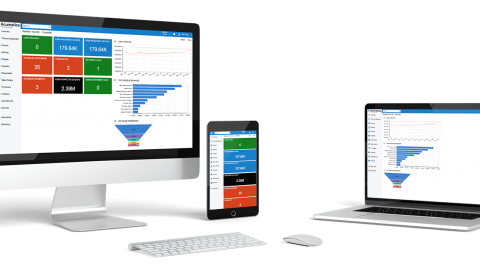Eliminating Manual AR Processes
For most companies today, managing accounts receivables (AR) activities is very manual processes. From managing several spreadsheets at once, having to manually renter data by hand, then moving information from one disconnected system to another, these manual AR processes are both tedious and inefficient. Maintaining some data in Acumatica and others in spreadsheets, while more information sits in a shared AR inbox in Outlook creates data pockets or silos that are time consuming at best but can cost far more in the long run.
These pockets need to be connected so AR teams can collaborate more effectively. Automation increases the connectivity between these disconnected pockets to improve accounting data input and reporting, enhancing collaboration and in turn improving operational efficiency. AR automation solutions are needed to connect information silos and enable collaboration of users. And with interest rates on the rise and more organizations tightening their belts, you can’t ignore your AR automation integration into Acumatica.
Moving as quickly and efficiently as possible is the goal of well-oiled accounting teams. The AR process, as a whole, is one big system, and needs multiple pieces working together in tandem for it to be successful. Once your invoice is generated, Acumatica becomes completely disconnected from the process. When only way you have to share information is to email PDFs back and forth to each other, and open them, read them, and manually enter them into Acumatica, processes get complicated. And as a result, you have all these disconnected systems, where teams are using one-off solutions to manage accounting workflows. And when processes involve so many manual steps, mistakes are inevitable.
Errors made by manual data entry can be prevented with AR automation. Beyond, this, automation can be leveraged as a “second set of eyes” to make sure you have everything you need to get your job done faster and more efficiently. When more than 40% of invoice disputes are the result of ‘invalid or missing purchase order information,’ these errors result real time (and money) lost.
With inflation hitting record numbers today, a customer paying 30 days late is equivalent to giving them a 1% discount on the invoice. What does your average days sales outstanding (DSO) look like today?
Because of resource constraints, many companies send an invoice and take no additional actions until the invoice is already late. Does this ring a bell? In today’s economy, this can result in significant capital loss for your bottom line.
Data shows that organizations relying on manual AR processes can only allocate 20% of their time chasing payments, while collectors with accounts receivable management automation spend 60% of their time talking with customers.
Leveraging AR automation in combination Acumatica is essential for companies to thrive and scale in 2022. Too often accounting solutions are thought of as expense savings, but they haven’t been a top priority due to bigger expense savings available in other departments. We’ve found that this is causing a massive amount of working capital not being employed today. And that’s because the sharing accounting data between companies is incredibly inefficient – people are still using manual tasks to extract, format, and distribute the vital accounting data that is at the heart of all business. And when you slow down access to accounting data, you slow down access to working capital.
Simply put, AR automation A connected accounting solution that integrates directly with Acumatica, like award-winning Lockstep Receivables, allows teams to reallocate their time away from clerical duties and focus it on communicating with customers, settling disputes, and other more critical tasks that lead to faster invoice collection.






















